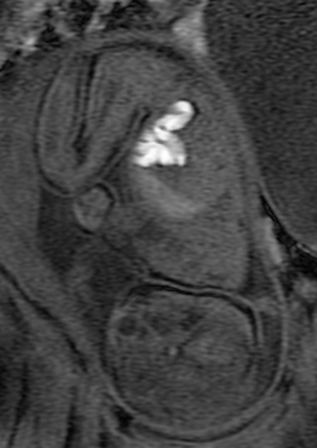Note: In this Q&A we adopt the convention that substances "bright" on T1-weighed images have short T1 values. This is true for most (but not all) pulse sequences. For a detailed explanation, click here.
|
Meconium has a very short T1 and moderately short T2 and therefore appears very bright on T1-weighted images and moderately dark on T2-weighted images. The brightness and amount of meconium increase distally within the bowel, being more prominent in the distal colon than in the jejunum. Both the amount of meconium and its T1 signal intensity increase throughout gestation.
Although several physical properties contribute to the relaxation times of meconium, the dominant process is likely the accumulation of paramagnetic substances within it. Minerals, including Fe, Mn, and Mg, constitute about 16% of the dry weight of meconium. Meconium also contains free fatty acids, carbohydrates, and mucin, all of which may further contribute to T1 shortening. However, meconium is still very bright after fat suppression pulses, implying the contribution of lipids must be minor. |
Advanced Discussion (show/hide)»
No supplementary material yet. Check back soon!
References
Farhataziz N, Engels JE, Ramus RM, et al. Fetal MRI of urine and meconium by gestational age for the diagnosis of genitourinary and gastrointestinal abnormalities. AJR 2005; 184:1891-189.
Farhataziz N, Engels JE, Ramus RM, et al. Fetal MRI of urine and meconium by gestational age for the diagnosis of genitourinary and gastrointestinal abnormalities. AJR 2005; 184:1891-189.
Related Questions
What is T1 relaxation?
Can you explain a little more about the dipole-dipole interaction? I still don't quite understand.
What is T1 relaxation?
Can you explain a little more about the dipole-dipole interaction? I still don't quite understand.

